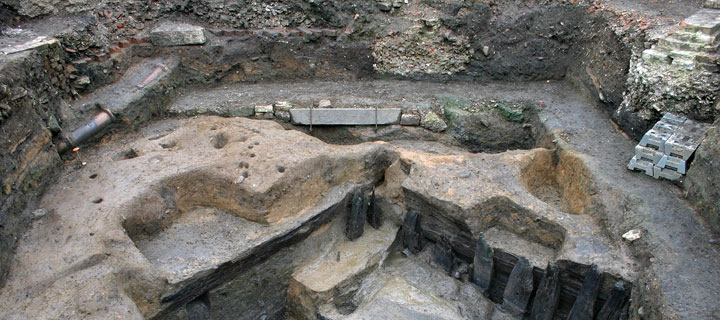
The excavations at Hungate, a feature of one of the exhibitions
Exhibitions
As part of the Festival, a number of exciting and informative exhibitions spanning several days will be shown at venues throughout the city. Their topics range from a celebration of Barnes Wallis, inventor of the "bouncing bomb", through to archaeological discoveries shedding more light on the fascinating past of York and its area. Entry costs vary, so be sure to check ahead of time.
Past events
Mesolithic deep time line, 13 June, Ron Cooke Hub
The concepts of time depth and the deep past's relationship to the present are central themes within Peter Watson's The Great Divide. However, the implications of these seemingly simple ideas can sometimes be difficult for us to fully comprehend. What does 15,000 years really mean in human terms?
Beeching 50 years on: The man who reshaped Britain's railways, 13-16 June, National Railway Museum
50 years ago Dr Richard Beeching wrote his revolutionary report, The Reshaping of British Railways. The report set in motion a radical restructuring of Britain’s railways that changed the face of rail transport. On the advice of his report many smaller railway lines were closed and "Dr Beeching" became the despised face of the cuts.
Strange bedfellows? Creativity and analysis in an age of austerity, 14-15 June, Ron Cooke Hub
When we talk about education policy, how often do we ask the rising generation – those who will be most affected by changes - for their views? This exhibition will tell the story and present the findings of the collaborative research project ‘Strange Bedfellows’.
Our daily bread, 15-16 June, 11am-4pm
An exhibition tracing the history and importance of bread in our diets: topics include the battle between white and wholemeal, how much bread we used to eat, bread in wartime and rationing, types of bread and sandwiches that we eat now. It will feature vintage recipes, advertisements and interesting facts and figures.
Barnes Wallis: In Yorkshire and beyond, 11-23 June, Merchant Adventurers Hall
The name of Barnes Wallis is inevitably linked with inventions which greatly contributed to the Allied victory in World War II, the Wellington, the bouncing bombs which breached the Mohne and Eder Dams, and the Tallboy and Grand Slam 'earthquake' bombs.
Tuberculosis - a short history, 21-22 June, York Medical Society
Tuberculosis (TB) is widely seen as a disease that is endemic across the world, but also one that has developed new strains that threaten to explode in epidemic proportions
Revealing York Minster - a heroic, historic, human journey, 13 June onwards, York Minster
Revealing York Minster - an interactive and fascinating exhibition beneath the Minster in the Undercroft which highlights the pivotal role of the Minster as the mother church of the north.
Royal Academy of Engineering: Design for living, 22-26 June, Ron Cooke Hub
Researchers from the University of York demonstrate that innovative advances in engineering are all around us, sometimes in unexpected ways, and that key scientific - and indeed artistic - achievements could not happen without a significant input from engineering. Come along and explore the world of acoustics, nanoparticles, neuroimaging, orange peel, and much more.
Capital of the North, 13 June onwards, Yorkshire Museum
In the medieval kingdoms of Britain, the north was ruled from York. Anglian kings were baptised in its churches, Viking warriors plotted their southern raids and the Normans cruelly stamped their authority on the masses. From the ravages of war, the city went on to flourish in a golden age of innovation, religion and trade.
After the ice: Yorkshire's prehistoric people, 13 June onwards, Yorkshire Museum
Eleven thousand years ago at Star Carr, near Scarborough, mesolithic people lived, hunted and worshipped. They built Britain’s oldest known house and wore deer skull headdresses to hunt or to worship unknown Gods. Some of the most remarkable and complete finds from the site are brought together for the first time in this special exhibition.
Fulford tapestry, 17-29 June, St Helen's Church
Fulford was the site of the first battle of 1066 that would spell the end of Anglo-Saxon rule. As the battle site could not be found the battle has been marked by creating a tapestry like the Bayeux Tapestry. It is not clear why these northern events are not part of our national consciousness. Perhaps the Fulford Tapestry will help to rectify this omission; it might be the only memorial to the first battle of 1066.
Looking back at Hungate, 13-29 June, DIG
From the 2006 to 2011 a team of archaeologists from YAT investigated the Hungate area of York as part of the regeneration of an often overlooked corner of the city. Artefacts discovered on the site help to tell the story of how people used this low-lying parcel of land over the last 2,000 years.
Three Graces 3sixty exhibition and talks, 29 June, Ron Cooke Hub
Victorian women artists’ works are often omitted from accounts of nineteenth-century art, leaving an incomplete and damaged picture of artistic developments. Women artists of the period remain largely misunderstood as incidental artists whose work is considered secondary to, and imitative of, their better-known male counterparts.

